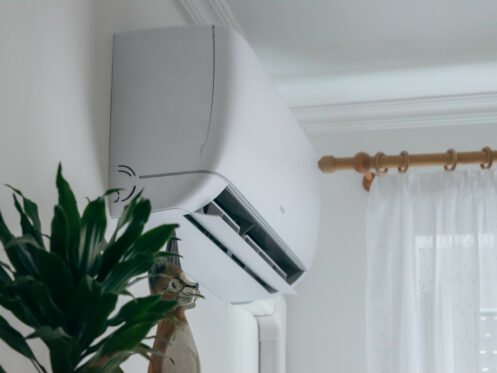Picking the right cooling system for your home is not something to think about lightly. The setup you choose will greatly impact your energy bills, comfort levels and indoor air quality. Some homes benefit more from central air while others do better with mini-splits. Speaking with an experienced HVAC technician at Loves Air is the best way to make an informed decision based on your home’s specific needs.
How Does a Central AC Work?
A central air conditioning system consists of one large cooling unit that cools the whole house. The compressor and condenser part of the system sit outside in a metal cabinet for protection. They connect to an interior air handler and evaporator coil via refrigerant lines. This setup sucks warm air out of the home, cools it using refrigerant and then sends it back inside the home and into each room through ductwork.
Depending on the size of the house, it may have a complex duct system consisting of main trunks, branch ducts and supply vents. Smaller homes usually have just supply ducts and return ducts. A thermostat connects to the system to control the temperature throughout the entire home.
What Is a Mini-Split and How Does It Work?
A mini-split has an outdoor part consisting of a condenser and compressor, too. It connects to at least one indoor air handler via a refrigerant line and electrical wiring. The air handlers mount to the wall, ceiling or floor in every room, and each one has its own thermostat.
There is no need for ductwork, making them an excellent option for homes without existing ducts or with add-on spaces. Most mini-split cooling systems use heat pumps, meaning they can reverse their refrigerant flow to provide heating in the winter.
Similarities
Mini-splits and central air conditioners have a lot in common. Understanding these similarities can help you compare your options more effectively.
Both Provide Whole-Room Cooling
Central ACs and mini-splits are both capable of keeping whole rooms and large spaces cool. They aren’t like window units that can only cool small areas. Whether it’s a small, single-story house or a large, multilevel home, both can keep you comfortable with optimal energy efficiency.
Both Use Refrigerant to Transfer Heat
Both systems use the same type of cooling process: They remove heat from the indoor air and send it outside. The refrigerant flowing through coils absorbs heat as it carries it away from the house. Once it releases the heat outdoors, it goes back inside the home to cool it down.
Both Require Professional Installation
If you think one system might be easy to install yourself, you’re wrong. Both require professional setup. A trained technician will have to connect wires, charge the system and test for leaks. Plus, only those with proper certification can legally install systems that use refrigerant.
Both Improve Indoor Comfort and Air Quality
Mini-splits and central ACs can both improve your home’s indoor air quality. As part of their cooling process, they suck humidity out of the air to reduce moisture-related problems, like mold growth and musty odors. Some models even have advanced air filtration built straight into the air handler. These versions do a great job at reducing dust and allergens to help with respiratory issues and allergy symptoms.
Main Differences
Even though central ACs and mini-splits have a lot in common, they also have several key distinctions. Familiarizing yourself with these differences will go a long way in helping you choose the best one for your house.
Central AC Uses Ductwork, Mini-Splits Do Not
With a central AC, your home will need a ductwork system that consists of supply ducts, return ducts and air vents. A technician may have to spend time balancing the airflow or making modifications to existing ducts to set up the new unit. They might also have to seal leaks if they notice any gaps or damage. With a mini-split, you don’t have to worry about ducts. Every zone gets its own air handler to deliver cool, conditioned air into it. Not having to install ductwork will speed up the installation process and may also make it cheaper in terms of labor costs.
Mini-Splits Offer Zoned Cooling, Central AC Does Not
One of the main advantages of a mini-split compared to a central AC is the ability to set different temperatures in different rooms. If you like your bedroom cooler than the rest of the house, you can easily adjust the settings. Or maybe you need to keep the garage cooler because you use it as a workout space or home office. With a mini-split, you get precise temperature control in each zone. Being able to cool only the parts of the home you use can save a significant amount of energy. Your AC will last longer thanks to the reduced wear, and your cooling costs will go down. A central AC doesn’t provide this type of zoned flexibility.
Mini-Splits Are Typically More Energy Efficient
Mini-splits don’t use ductwork like central ACs, so there’s less energy loss. You won’t have to worry about conditioned air escaping through leaky ducts and poorly sealed connections before it reaches each room. Instead, all of the air will flow directly into the space it’s meant to cool or heat. This improved energy efficiency helps the HVAC last longer and use less energy to keep the home comfortable.
Central AC Units Are Less Visible Indoors
The indoor air handlers of a mini-split hang on the wall or from the ceiling or sit on the floor. They take up space and are very visible. With a central AC, the indoor air handler sits inside a closet or utility area, tucked away out of sight. You won’t have to deal with visible equipment or the impact on your interior decor.
Factors to Consider When Choosing a System
Not all homes are the same. There are several factors you need to think about to ensure you pick the ideal HVAC setup for your house:
- Home size and layout: Larger homes benefit from central systems.
- Existing ductwork availability: No ducts? Mini-splits are easier.
- Energy efficiency goals: Mini-splits often use less electricity.
- Cooling preferences: Choose a mini-split for zoned room control.
Speaking With a Professional HVAC Technician
Before you make a final choice, we highly recommend contacting us to schedule an inspection. We can assess your home’s unique cooling needs, like room layout and insulation quality, to pick a setup that fully matches your comfort and efficiency goals. We’ll also check the ductwork to see whether it has any severe leaks or damage. If it does, a mini-split system will almost always make more sense. Having to repair damaged ducts may require cutting into walls or ceilings, which can be incredibly expensive to perform. Upgrading the home with a mini-split gives you the ability to cool each space independently without having to rebuild or extend existing ductwork.
Loves Air offers top-tier installation support for central ACs and mini-splits. We also make it simple to book timely repairs and tune-ups for systems of all types. Call Loves Air now to schedule an AC inspection for your home in Modesto, CA.



